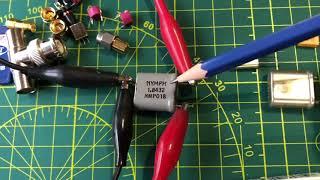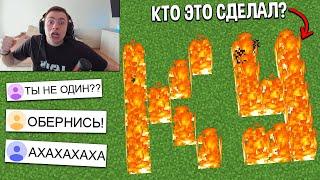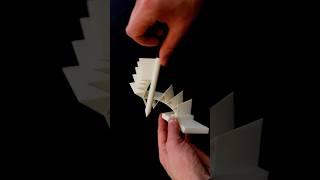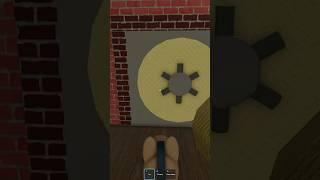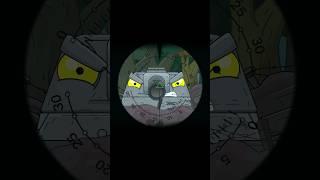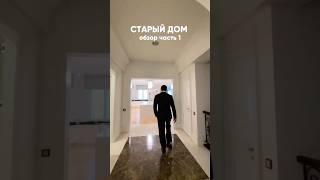
nanoVNA - Determining the Resonant Frequency of Crystals - VE6WGM
Комментарии:

Old crystals have usually a fundamental frequency below 10MHz. Above they used an odd mode, i.e. x3,x5 x7 x9. VHF frequency crystal used a more complicated formula... They use harmonics and plus or minus IF frequency (not always 455kHz).
Ответить
Very good video
Ответить
Hi, well done video. My question: what about initial calibration and other ones during the next steps of measures?
Ответить
How do you know if Isolated and thought calibration is accurate? Sorry that part was not clear to me
Ответить
Are my horde of 100s of 75 year old radio crystals still good if stored properly?
Ответить
What I think you're seeing:
"Every quartz blank has its basic frequency. Besides this “fundamental tone”, each quartz disc has several overtones. When electric voltage is applied to the quartz, it oscillates on its fundamental tone. Its overtones are also triggered in this process, but their signal is significantly weaker than that of the fundamental tone. In fact, most of the time the overtone signal results in nothing more than normal phase noise.
"By clever construction of the oscillator circuit, it is possible to actuate the overtone of the quartz instead of the fundamental tone. Therefore, an additional resonant circuit is added to the oscillator circuit in order to amplify the overtone signal of the quartz.
"This technique allows engineers to “squeeze” frequencies far above its fundamental tone out of a quartz crystal. For example, if a quartz oscillates in the fundamental tone at 20MHz, the third overtone oscillates at 60MHz and the fifth overtone oscillates at 100MHz. Due to the electronic properties of the oscillator circuit, the overtones can only be stimulated in the odd integer range"
.

bravo!!!!
Ответить
By placing a piece of copper wire like a hairpin or some coils between the two ends, it acts as a griddip
Ответить
Are you a electrical engineer? Or what is your title for your career ?
Ответить
You can also use a spectrum analyzer and tracking generator
Ответить
Nice demonstration, not to complicated to follow along with.
Nice job 👍
KN6JHC

Your testing here is fascinating, really useful and enjoyable, thank you for sharing.
Ответить
Thanks for sharing crystal oscillator.
Ответить
Muchas gracias muy util tu video y la explicacion que das alli , tenia que medir unos cristales de un generador de carrier de un radio hf y no sabia como hacerlo gracias a tu video pude medir los cristales y verificar que estaban resonando a la frecuencia adecuada gracias de YV5JAU
Ответить
Super c'est mon cours de rf merci
Ответить
Hi you made a very informative and interesting demo. can you please explain how you took account of or calibrated the SMA to crocodile clip cable impedance in the VNA setup Many thanks
Ответить
You didn't show the menu settings for the NanoVNA to get it into the right mode for measuring crystal freqs. E.g., Start and Stop freqs.
Also, you did not show/describe the physical cable / alligator clip rig.

Here are my suggestions:
1. Instead of using alligator clips and cables, use a solderless breadboard (with .1” spaced rows) and appropriate SMA connectors (and the SMA cables that came with the NanoVNA0.) The setup is much more solid and results are more repeatable.
2. Use the nanoVNA-saver SW. Manipulating the scan parameters, the markers etc. is a lot easier. It also has a function called “Analysis” that identify the peak resonance frequency (when already in range, of course).
Great video nevertheless. You should show how to compute the parameters of crystals such as Lm, Cm, and ESR using the values acquired by the nanoVNA. Also, show how to measure the package capacitance Ck.

Hi,thanks a lot for your video about nanovna
Greetings from Buenos Aires,Argentina

You should be a professor in this field of science! Excellent teaching ability!!
Ответить
I like the video, but a more detailed shot of how the Nano was wired to the 2 ports and the crystal would have been helpful. the Nano is great but has a long learning curve!
Ответить
What's more important thing is how to connect wire to VNA and to the crystal! But you don't show me this. Would you?
Ответить
Thanks for a great lesson on resonance circuits , I received my nanovna saa a couple of days ago primarily to tune air core coils and the cells in an hho generator. Your description is the best I've seen and as someone commented the vna been used as a spectrum analyzer tends to divide peaks from a quality signel generator into 2 maybe because it relies on harmonics to cover it's sweep frequency range. I belive the V2 plus 4 does not use harmonics to sweep the declared range but is twice the price..
Looking forward to your next lesson 😀

Crystal appears to have a spurious response
Ответить
I think we can all agree that a nanovna is better than a set of Gensu knives as far as versatility and utility, and Greg's excellent video is more proof.
I did watch a video on why a nanovna is not so great when used as spectrum analyzer due to internal filtering artifacts as someome else mentioned.
That does cause me to wonder if a narrower calibration range might help cure "some" of the artifacts, if that is what is being observed.
If I hadn't seen the video on using a nanovna as a spectrum analyzer, I would be thinking of other related weaker frequencies in the crystal that muscians would refer to as timber of an instrument. Crystals are natural resonant structures and I would expect some frequency impurities away from the fundamental designed frequency.
Then the more engineer mind thinks, is there a reaction between the crystal and its housing?
Lots of thoughts.
Again, thanks for a great video.

How about figuring out why resistors overheat in a circuit come on help me
Ответить
How did you do your calibration using the alligator clips? Especially the 50ohm cal
Ответить
Makes sense, that a 6.8M crystal third order is 20.45M. That is usually its strongest harmonic I believe. These are great videos. I just recieved my vnaF and learning alot here.
Ответить
Greg, very well done and presented. As Nelville points out, crystals are sometimes optimized to operate on fundamental OR if higher frequency needed, their 3rd and sometimes 5th harmonic; i.e.: 3rd and 5th “overtone”. It’s difficult to process a crystal with a fundamental frequency in the 10’s or 100’s of MHz as they get very thin and thus fragile so overtone crystals are very common above about 20mhz.
Ответить
I noticed that he is controlling his VNA with a pencil eraser, better he should use the soft graphite end, the eraser is rubber compounded with pumice an abrasive powder, so he is gently damaging the surface of his glass of plastic screen protector minutely with every stroke. That damage is cumulative.
Otherwise a nice presentation. Ron W4BIN

Excellent video, unhurried and comprehensive explanation, thanks Gregg. I really enjoyed it!
Ответить
could you post what parameters in the menu you used. I see how the crystal was physically connected, but not which settings to use.
Ответить
Sometimes the marked frequency is the receive frequency of a receiver. The actual crystal frequency is the local oscillator frequency of that receiver.
Ответить
tip: set your SPAN to say 5MHz, then you need only set the CENTER when you're moving up in your initial search, then when you get something close, you can shrink the SPAN.
Ответить
Broken crystals can do weird things. Great video and excellent description of crystals! Thanks!
Ответить
In the 70's and 80's, I ordered many xtals from Jan Crystals. They asked for fundamental frequency, series or parallel resonance, 3rd or 5th overtone, series or parallel capacitance. A lot depended on the actual crystal oscillator. Shame I didn't keep old jan crystals catalogues, thanks for posting. VK2FP/AG7VC.
Ответить
Very interesting Gregg,
we used to use this harmonics effect a lot back in the 70's - 80's as a cheap replacement for our 2Mtr xtal rigs ( 145.500 -10.7 ) / 5 = 26,96

большой кварц на третей гармонике работает, у меня такие встречались, непонятно каким образом , но они работали
Ответить
How exactly did you connect the crystal to the ports? And is it also possible to measure coils and capacitors this way?
Ответить
well done Gregg, great video. Your conclusions are spot on. Some crystals are manufactured to operate on their fundamental frequency, some others are manufactured to work at their third overtone.
Ответить
Us crusty old hams don't need fancy electronics. We know that all you have to do is jumper the crystal in series with the antenna to the receiver. As you tune across the 'supposed/suspected/marked' resonant frequency the incoming noise/signals will jump in amplitude quite dramatically - usually blowing your headset off. All done in moments and it's Miller time.
Ответить
Please post/show the hookup for the crystal to the NanoVNA to measure this and other things. This video didn't exactly explain or show it so I can pass it on to others that are asking. Could you also show how you calibrated this set of test leads to get the reference plane correct.
KV4ATV Florida

Those "multiple resonance" frequencies are interesting. What would happen if you re-calibrated at the narrow sweep range you used after adjustment? I have no idea what's going on but I wonder if the extra resonances are an artifact of the measurement device? Or caused by the extra inductance / capacitance of the connecting cables? My nanoVNA is in the mail LOL.
Another experiment - test a crystal connected at the end of a 100 ft long piece of coax!

If you connect the crystal only to port 1 the same as when checking coils and caps what do you get?
Ответить